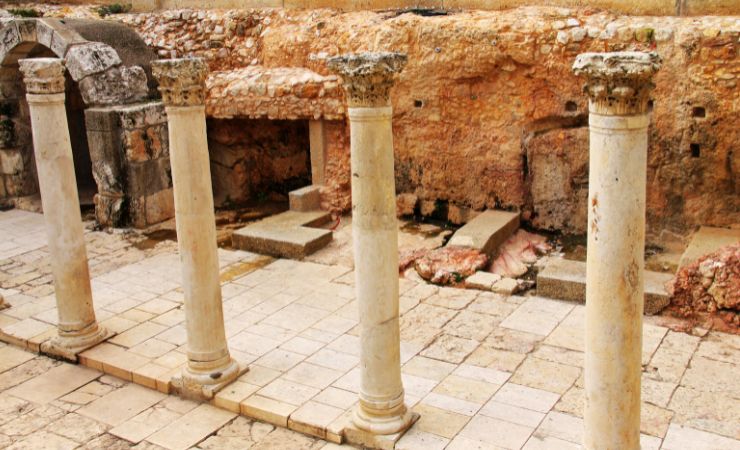Cardo Maximus: The Historical Backbone of Jerusalem
The Cardo Maximus in Jerusalem was the main north-south thoroughfare in the ancient Roman and Byzantine city. The word Cardo means in Latin ‘hinge’ or ‘axis’. Today, remnants of this historic street can be seen in the Jewish Quarter of the Old City. It stretches from the Damascus Gate to the north, almost reaching the Zion Gate in the south.

Historical Context
The Madaba map, a relic from the sixth-century CE, prominently displays the Cardo Maximus. This map reveals the Nea Church, with its distinctive red roof, situated a short distance from the Church of the Holy Sepulchre. This Byzantine portrayal of the Cardo Maximus paints it as a bustling Roman-style avenue, lined with colonnades.
For a long time, it was widely accepted that the Roman emperor Hadrian was the mastermind behind the Cardo Maximus, especially after he rechristened Jerusalem as Aelia Capitolina in 135 CE, following the Second Jewish Revolt. However, excavations in the 1970s show a different story. These digs, particularly in the Cardo Maximus’s southern section, hinted at the Byzantine emperor Justinian I’s involvement in constructing parts of the street. This theory gained traction when the magnificent Nea Church’s discovery was linked to the Cardo’s history. Oren Gutfeld, in his article “The Emperor’s New Church on Main Street, Jerusalem,” delves deeper into this connection. So the current theory is that the Cardo Maximus may have been used for ceremonial processions from the Nea Church in the South of the City to the Church of the Holy Sepulchre.



Archaeological Insights
1970s Excavations: In the 1970s, a series of excavations in the Cardo’s southern region led to a groundbreaking theory. These digs suggested that the Byzantine emperor Justinian I might have played a role in constructing certain sections of the Cardo Maximus. This hypothesis was further bolstered by the discovery of the Nea Church, which was intricately linked to the Cardo’s history.
Nahman Avigad’s Discoveries: Between 1970 and 1981, Nahman Avigad led excavations on a 600-foot stretch of the Cardo’s southern part. These digs unearthed around 60 Byzantine architectural elements, including column bases, columns, and capitals. Interestingly, while some column bases remained in their original position, many architectural features found new life in subsequent structures along the Cardo. A significant revelation was that this section of the Cardo was constructed directly atop bedrock, devoid of any prior Roman construction signs. This discovery lent credence to the theory that Justinian might have overseen the Cardo’s southern part construction.
The Nea Church: Avigad’s excavations also brought to light a splendid basilica identified as the Nea Church. Gutfeld posits that Justinian’s intent behind the Nea Church was to counterbalance the Church of the Holy Sepulchre. Furthermore, he suggests that the emperor aimed to extend the Cardo southwards, creating a paved route connecting the Nea Church to the Holy Sepulchre. This theory is further supported by Justinian’s court historian, Procopius, who described the Nea Church as a grand structure, partly built on natural rock and partly elevated by artificial extensions. Excavations revealed six massive vaults supporting the Nea Church’s southeastern section. One of the Nea’s original columns still stands adjacent to King David’s Tomb and the Room of the Last Supper.
The church itself was a grand triapsidal basilica, with dimensions rivaling the famed Hagia Sophia in Constantinople. The Nea’s interiors boasted a long nave flanked by two side aisles, separated by columns. Cyril of Scythopolis, a renowned chronicler, was present during the church’s consecration in 543 CE. He praised the church, stating that it surpassed all ancient marvels documented in Greek history.
Sources and Additional Reading
Maslulim Israel (in Hebrew)
Israel365 News – The Cardo
Who built the Cardo in Jerusalem
Sites Along the Cardo Maximus
- Damascus Gate: Located in the North of the Old City, the Damascus Gate is one of the main entrances to the Old City of Jerusalem.
- Station 7 of the Via Dolorosa: Station 7 marks the spot where Jesus fell for the second time on his way to Golgotha.
- Alexander Nevsky: The Alexander Nevsky Church is a Russian Orthodox church that is named after a Russian prince and saint.
- Byzantine Open Cardo: The Byzantine Open Cardo is a section of the ancient north-south-oriented street in Jerusalem.
- The Broad Wall: The Broad Wall is a massive defensive wall from the First Temple period. Its discovery shed light on the city’s boundaries during the reign of King Hezekiah.
- The Madaba Map Jerusalem: The Madaba Map is an ancient mosaic map found in Jordan, depicting parts of the Middle East, including Jerusalem.
- The Hurva Synagogue: The Hurva Synagogue has a tumultuous history of destruction and reconstruction.



